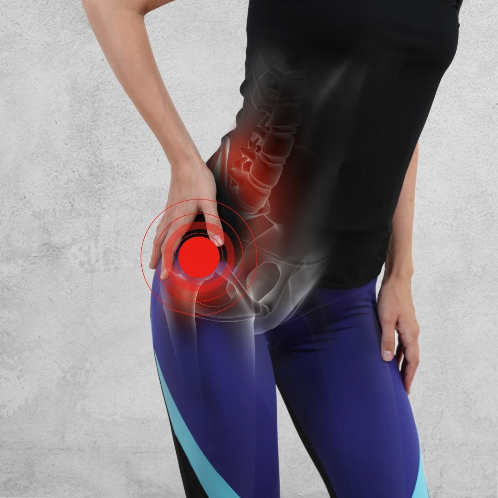Trying to stay active but your knees and hips are putting you out of commission? It’s common with aging to have aches and pains in the hips and knees. These are the largest joints in your body. Aging isn’t the only reason though as young athletes will experience this type of tightness and pain from overuse.

The most common reason you may experience knee and hip pain is from repetitive motions. These don’t even need to be strenuous activities either. Plenty of people have discovered knee and hip pain from gardening.
And still others will have bursitis, where the knee becomes inflamed, while others will have osteoarthritis, a deterioration of the joints most commonly with knees and hips. But how do you know what’s causing it? For that, you’ll need a doctor, but it’s safe to say if you experience any unusual symptoms, something isn’t right.
5 Telling Symptoms of Knee and Hip Pain That Need Attention
Since your knees and hips are such an integral part of motion for your body, you should never ignore certain symptoms. There are many things you can do to get relief, but knowing the causes of that knee and hip pain will help you form a targeted treatment plan to gets you back in motion again.
1. You can’t do what you love
Knee and hip pain that interferes with the things you do in your normal lifestyle should always be addressed. Whether you regularly enjoyed walking at the park or were more active with tennis or cycling, if you have trouble doing these activities now, it’s time to have it looked at.
2. The pain makes it impossible to sleep
Inflammation happens as a reaction to pain. That inflammation gets worse at night which can make it difficult to get a good night’s sleep. If you’re in such pain that you can’t go on, life is not meant to be lived like this.
3. You hear or feel popping and locking
The cartilage in your joints of the knees and hips is an essential element. When it catches, pops, or locks, it’s a sign that some bits of it have broken off. You’ll want to have this taken care of quickly to prevent more wear down of that cartilage.
4. Doing simple tasks is difficult
Is it hard to put your socks and shoes on now? When you bend over, do you feel like you can’t get up? These are unfortunate signs that your knee and hip pain should not be ignored.
5. You experience swelling
This is especially noticeable in the knees. Swelling can be an indicator that the cartilage in your knees or hips is wearing down.
What You Can Do About Your Knee and Hip Pain
The very first thing you need to do is see a doctor to evaluate the cause of your knee and hip pain. Since these pains can be caused by several different things, you need to know the exact cause to find the best treatment.
Many people fear going to the doctor because they don’t want to have surgery. It’s a common fear, but the good news is that surgery is often a last resort. You’ll likely receive a list of recommended exercises to do each day that will help you move through the pain.
Best Exercises for Knee and Hip Pain
Exercise is one of the best habits you can have, no matter your age. According to Harvard, it can help with many knee and hip problems, regardless of their cause. If you build up the muscles around your knees or hips, you can help support those joints by letting the muscle do more of the heavy lifting.
Since muscles work in pairs, keeping balance will prevent joint problems and injuries. Doing flexibility exercises can improve the functions of your knees and hips. Working with a physical therapist can help ensure you’re doing all the right moves and making progress in your health and recovery.
Sometimes, gait retraining is necessary since knee and hip problems will lead to a change in the way you walk. If you’ve adjusted the way you walk to avoid pains, it could suddenly come up years down the road in the form of an injury.

Along with a physical therapist, here’s what else you can do to get your knees and hips feeling less tight, more mobile, and feeling better than you have in ages:
- Get in the pool
Swimming is one of the best ways to get the exercise you need without irritating your joints. The water supports your body weight and helps you have more mobility. This makes it easier to do exercises that you’d struggle with on dry land.
- Indoor exercises
Simple floor exercises on a mat can help you build up your joints again. The key is to go low and slow. Stretches with exercise balls, abdominal curls, leg lifts, and hand weights can all be incorporated into a great exercise routine that helps you recover.
- Yoga
The gentle stretching of yoga not only improves flexibility and mobility, but it also improves your mental well-being. Yoga can be a blessing to many that suffer from knee and hip pain.
- Focus on stretching and mobility
One last element that can help address the tightness in your joints and muscles is stretching and mobility. These go hand in hand, though it can be extremely difficult to do the stretches you need to become more mobile. The 3L Fit Double Roller can help you build up that strength you’ve been missing and allow for a greater range of motion with continued use.

The Bottom Line
Knee and hip pain shouldn’t be ignored. There are ways to treat it to restore your mobility again. It all starts with determining the cause of your pain and working on ways to strengthen your body again. With a little effort on your part, you’ll be able to get back to doing the things you love.

Comentarios